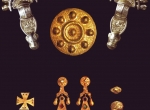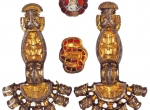Langobards
Lombards, according to the Origo gentis Langobardorum saga dated to the 6th century the tribe Vinnili resided on the Scandinavian island of Scadanan. Odin himself gave them their name, supposed to mean “the Long beards”. However, this Scandinavian origin has to be treated as a myth for some other Germanic tribes claimed as similar homeland. The Greek historian Strabo recorded that L. were a branch of the Suebi; according to Velleius Paterculus they surpassed other tribes in savagery. In the 1st and the 2nd century they lived in the region to the east of the Lower Elbe (from today’s Hamburg to western Mecklenburg), archaeologically their material culture is classified among that of Germanic north Elbe tribes.
The last written reference to the L. comes from around AD 150 when they are credited with initiating the Marcommannic Wars; in 167/168, together with the Obi, they invaded the Roman provinces on the Danube. Next, L. disappear from the written record for more than three centuries. They come into focus of classical authors again only during the 480s when they occupy Lower Austria and Moravia (Rugiland), vacated by the tribe of the Rugii. According to the most recent the long silence on the subject of L. has something to do with the emergence of a new ethnos of the same name, mostly with participation from Germanic Elbe tribes. Around 510 L. defeated the →Heruli and made them their tributaries. The cause of the conflict between the two tribes is unclear but its result was consolidation of the L. position on the Danube. Soon afterwards they expanded their territory and occupied Pannonia. Using a skilful policy of intermarriage with the elite of the →Thuringi, →Gepids and →Franks , the L. king Wacho succeeded in consolidating his power.
In 535 the Emperor Justinian allied himself with the L. to whom, in exchange for their support in the wars against the Ostrogoths →Ostrogoths , he promised to cede the western part of Illyria. By doing so he was able to secure for himself on overland link between the Balkans and Italy, by way of the territory of the allied tribes.
L. played a significant role in the wars between Byzantine Empire and Ostrogoths in Italy and in the defeat of the latter in 552. In exchange the Byzantine Empire supported L. in their conflict started during the 550s with their neighbours the Gepids. In 566 Alboin, newly elected as king of the L., concluded an alliance with the Avar and, with them, he succeeded to finally defeat the Gepids. A turning point in the history of the L. was 568 when, with groups of Suebi, Sarmatians and Bulgars inhabiting Pannonia, under Alboin’s leadership they broke into Italy where Alboin established his kingdom and allowed the Avar to take possession of Pannonia. Alboin’s death in 574 was followed by a brief interregnum as a result of which his kingdom fell apart, reinstated only in 584 in northern and central Italy.
The last L. king was defeated by Charlemagne who took the title of rex Francorum atque Langobardorum and so, de jure, put an end to L. rule in Italy. Their name survives at present in the appellation of a geographic region of northern Italy – Lombardy.
JS
Literature: I. Bóna, Langobarden in Ungarn. Aus den Ergebnissen von zwölf Forschungsjahren, Arheološki Vestnik 21-22, 1970/71, p. 45-74; J. Jarnut, Geschichte der Langobarden, Stuttgart, Berlin, Mainz, Köln 1982; G. Hauptfeld, Zur langobardischen Eroberung Italiens. Das Heer und die Bischöfe, Mitteilungen des Instituts für Österreichische Geschichtsforschung 91, 1983, p. 37-94; V. Bierbrauer, Archäologie der Langobarden in Italien: ethnische Interpretation und Stand der Forschung [in:] W. Pohl, P. Erhart (Eds.), Die Langobarden – Herrschaft und Identität, Österreichische Akademie der Wissenschaften, Philologisch-Historische Klasse, Denkschriften 329. Wien 2005, p. 21-66; M. Hegewisch (Ed.), Die Langobarden. Das Ende der Völkerwanderung. Katalog zur Ausstellung im Rheinischen Landesmuseum Bonn 22.8.2008–11.1.2009, Bonn, Darmstadt 2008; W. Pohl, Migration und Ethnogenesen der Langobarden aus Sicht der Schriftquellen [in:] J. Bemmann, M. Schmauder (Eds.), Kulturwandel in Mitteleuropa. Langobarden – Awaren – slawen. Akten der Internationalen Tagung in Bonn vom 25. bis 28. Februar 2008, Bonn 2008, p. 1-12; M. Mączyńska, Światło z popiołu. Wędrwówki ludów w Europie w IV i V w., Warszawa 2013, p. 233-244, 249-253.
-
 full resolution
full resolution
Fig. 1. Suite of jewellery of mixed Langobard/local From a female grave, cemetery at Castel Trosino, Italy (M. Hegewisch 2009)
-
 full resolution
full resolution
Fig. 2. Matching brooches from a Langobard grave, cemetery at ? Hungarian Kajdacs, in Pannonia (M. Hegewisch 2009).


